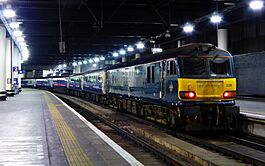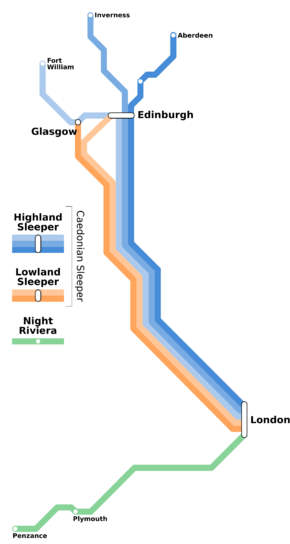Caledonian Sleeper facts for kids
The Caledonian Sleeper is a special overnight train service in the United Kingdom. It connects London with different parts of Scotland. Imagine going to sleep in London and waking up in Scotland! This train is one of only two overnight sleeper services running in the UK today. The other one is the Night Riviera, which travels between London and Penzance.
Sleeper trains have been running on the West Coast Main Line since 1873. For a long time, there were also sleeper trains on the East Coast Main Line. However, these services stopped in 1988. The Caledonian Sleeper has changed hands a few times. It was part of ScotRail for many years. Since 2015, it has been a separate service. New, modern trains called Mark 5 carriages were introduced in 2019. These replaced the older trains.
In June 2023, the Scottish Government took over running the service. It is now managed by Scottish Rail Holdings.
Contents
History of Sleeper Trains
Early Sleeper Services
The very first sleeping car in Britain was shown in February 1873. It was built by the Ashbury Carriage Company. This special carriage made its first trip on February 24, 1873. It traveled from Glasgow to London King's Cross on the East Coast Main Line.
Later that year, on October 1, 1873, the Caledonian Railway started its own sleeper service. This train ran between Glasgow Buchanan Street and London Euston. It used the West Coast Main Line. Passengers paid an extra ten shillings to have a sleeping bed.
For over 100 years, sleeper trains ran on both the west and east coast routes. They went to many different places. Even when the railways were owned by the government under British Rail, these services continued. By 1976, you could take a sleeper from London King's Cross to Edinburgh and Aberdeen. From London Euston, you could go to Glasgow, Perth, Inverness, Stranraer Harbour, and Fort William. There was also a service from Bristol to Glasgow and Edinburgh.
Changes and Withdrawals
However, the number of sleeper services started to decrease in the late 1900s. In 1987, it was announced that the last sleeper trains on the East Coast routes would stop running in May 1988.
In 1995, the Anglo-Scottish sleeper services were moved to ScotRail. There was a plan to stop the service to Fort William. But, after some discussion, British Rail agreed to keep it. However, the number of sleeping carriages for Fort William was reduced. The service that carried cars, called motorail, was stopped completely in 1995.
The Caledonian Sleeper Today
Starting the New Brand
On June 4, 1996, the overnight service was relaunched. It was given the new name, Caledonian Sleeper. Each part of the service had its own name. For example, the train to Glasgow was called the Night Caledonian. The one to Edinburgh was the Night Scotsman.
On March 31, 1997, the service became part of the ScotRail franchise. This was operated by National Express at first. The trains used the same Mark 3 sleeping cars as before. In January 2000, seated carriages were added to the trains. These were Mark 2 carriages that had been updated. The sleeping cars were also refurbished and repainted.
On October 17, 2004, the ScotRail franchise, including the Caledonian Sleeper, was transferred to FirstGroup.
Serco Takes Over
In 2012, the Scottish Government decided that the Caledonian Sleeper would become a separate service. In May 2014, Serco won the contract to operate it. Serco promised to invest £100 million in new trains. These new trains would have rooms with their own bathrooms and a new style of club car.
On March 31, 2015, Serco Caledonian Sleepers began operating the service. New Mark 5 carriages were introduced in 2019. These modern trains replaced the older ones.
During 2019 and 2021, there were some strikes by staff. These were due to disagreements over working conditions and pay. The service was also affected by the UK railway strikes that started in 2022.
In October 2022, the Scottish Government announced that Serco's contract would end. The service was taken over by Scottish Rail Holdings on June 25, 2023.
How the Trains Run Now
Two Caledonian Sleeper trains run six nights a week. They do not run on Saturday nights or Sunday mornings. Both trains start from London Euston. They travel along the West Coast Main Line to Scotland.
The first train is called the Highland Sleeper. It splits into three parts at Edinburgh. These parts then go to Aberdeen, Fort William, and Inverness.
The second train is called the Lowland Sleeper. It splits into two parts at Carstairs. These parts go to Edinburgh and Glasgow.
Five trains then leave from these Scottish cities each night. They combine into two trains at Edinburgh and Carstairs to travel back to London. The trains usually travel at up to 80 miles per hour. They can go up to 100 miles per hour if they are running late.
Sometimes, on Sundays, the trains might use the East Coast Main Line instead. This happens if the West Coast route is closed for maintenance. If London Euston station is closed, they might use London King's Cross instead.
Caledonian Sleeper passengers can use special lounges at several stations. These include Dundee, Fort William, Inverness, and Perth. They can also use shared lounges at Aberdeen, Edinburgh, Glasgow, and London Euston.
The Highland Sleeper Route

The northbound Highland Sleeper leaves London Euston at 9:15 PM (8:59 PM on Sundays). It stops at Watford Junction, Crewe, and Preston to pick up passengers. It arrives at Edinburgh Waverley about six and a half hours later. This long train has 16 carriages and is pulled by an electric Class 92 locomotive.
At Edinburgh Waverley, the train is divided into three separate parts. Each part then continues north with a different diesel locomotive, a Class 73/9.
- The front part goes to Fort William.
- The middle part goes to Aberdeen.
- The rear part goes to Inverness.
These services arrive at their destinations the next morning.
For the southbound journey, three separate trains leave Aberdeen, Inverness, and Fort William in the evening. They are pulled by a Class 73/9 locomotive to Edinburgh. At Edinburgh Waverley, these trains are joined together to form one 16-carriage train. A Class 92 electric locomotive then pulls the full train to London Euston. It stops at Preston and Crewe for passengers to get off.
The Inverness part of the train has six sleeping coaches, one seated carriage, and one "club car" (a lounge car). The Aberdeen part has two to four sleeping coaches, one seated carriage, and one lounge car. The Fort William part has two to four sleeping coaches. Seated and lounge carriages for Fort William are added or removed at Edinburgh. This means if you travel in a seat from England to Fort William, you might need to change carriages at Edinburgh.
| Highland Caledonian Sleeper | |
|---|---|
| Route | Calling at |
| London Euston – Fort William |
|
| London Euston – Aberdeen |
|
| London Euston – Inverness |
|
The Lowland Sleeper Route
The northbound Lowland Sleeper leaves London Euston at 11:50 PM (11:30 PM on Sundays). It stops at Watford Junction to pick up passengers. The train then travels without stopping until Carlisle, before reaching Carstairs.
At Carstairs, this train also divides into two parts. The front eight carriages continue to Glasgow Central. They make one stop at Motherwell. The rear eight carriages reverse direction at Carstairs and go directly to Edinburgh Waverley. Both parts arrive at their destinations the next morning. Carlisle, Carstairs, and Motherwell are only for passengers getting off the train.
For the southbound journey, two separate trains leave Glasgow Central (stopping at Motherwell) and Edinburgh Waverley. They combine into one train at Carstairs. The train then stops at Carlisle. It travels non-stop to Watford Junction (for passengers getting off) and ends its journey at London Euston the next morning. Motherwell, Carstairs, and Carlisle are only for passengers getting on the train.
| Lowland Caledonian Sleeper | ||
|---|---|---|
| Route | Calling at | |
| London Euston – Glasgow Central |
|
|
| London Euston – Edinburgh Waverley |
|
|
Train Carriages and Locomotives
The Caledonian Sleeper used to have Mark 3 sleeping coaches and Mark 2 seated carriages. Some of these Mark 2 carriages were lounge cars where people could get food and drinks. In 2019, these were replaced by new Mark 5 carriages. The new trains started running on the Lowland services in April 2019 and on the Highland services in October 2019.
Two types of locomotives (the engines that pull the trains) are used for the Caledonian Sleeper.
- On the electric railway lines between Glasgow/Edinburgh and London, electric locomotives pull the trains.
- On the non-electric lines in Scotland, diesel or electro-diesel locomotives are used.
Current Fleet
| Class | Image | Type | Top speed | Fleet size | Usage | Built | Notes | |
|---|---|---|---|---|---|---|---|---|
| mph | km/h | |||||||
| 67 |  |
Diesel-electric locomotive | 125 | 200 | 2 | Edinburgh - Aberdeen/Fort William/Inverness | 1999-2000 | Hired from GB Railfreight. |
| 73/9 |  |
Electro-diesel locomotive | 90 | 145 | 6 | 1962, 1965–1967 (Rebuilt 2014–2017) |
||
| 92 |  |
Electric locomotive | 87 | 140 | 7 | London - Glasgow/Edinburgh | 1993–1996 | |
| Mark 5 |  |
Passenger carriage | 100 | 161 | 75 | Full network | 2016–2018 | |
Past Fleet
Here are some of the train types that used to be part of the Caledonian Sleeper fleet:
| Class | Image | Type | Top speed | Fleet Size | Usage | Built | Left fleet | |
|---|---|---|---|---|---|---|---|---|
| mph | km/h | |||||||
| 37/4 |  |
Diesel-electric locomotive | 90 | 140 | Edinburgh - Fort William | 1960–1965 | 2006 | |
| 67 |  |
125 | 200 | Edinburgh - Inverness | 1999–2000 | 2019 | ||
| 86 | Electric locomotive | 110 | 177 | 2 | London - Edinburgh/Glasgow Sleeper Portions. Empty Coaching Stock (London - Wembley) |
October 1965 | ||
 |
100 | 161 | January 1966 | |||||
| 87 |  |
110 | 177 | 1 | June 1973 | |||
| 90 |  |
- | London - Glasgow/Edinburgh | 1987–1990 | ||||
| Mark 2 |  |
Lounge car Seated coach |
100 | 160 | 22 | Full Network | 1969–1974 | |
| Mark 3 |  |
Sleeping car | 125 | 200 | 53 | 1975–1988 | ||
Incidents and Safety
When the new Mark 5 carriages were first used in April 2019, the very first journey was delayed by over three hours. Other services in 2019 also experienced delays due to "technical faults."
On August 1, 2019, after a train was split at Carstairs, a valve that controls the brakes was closed. This meant the brakes could not be controlled from the locomotive. As a result, the Edinburgh part of the train went past the platform at Edinburgh Waverley. The Rail Accident Investigation Branch looked into this incident. They made two suggestions to improve safety. One was to make sure brake tests are done after all parts of the train are connected. The other was for Caledonian Sleeper to check how easily these brake valves could be accidentally moved.
Images for kids
See also









